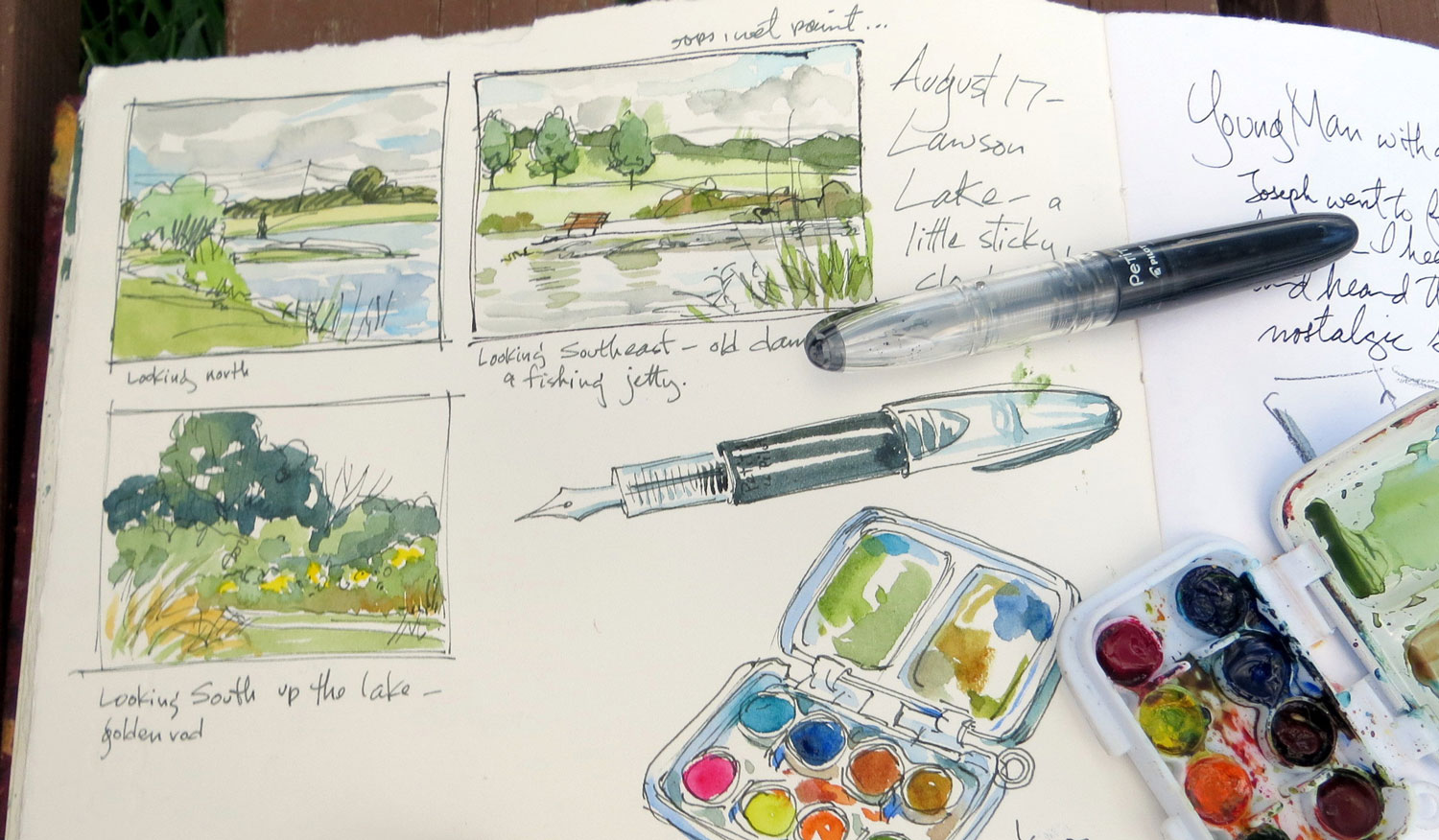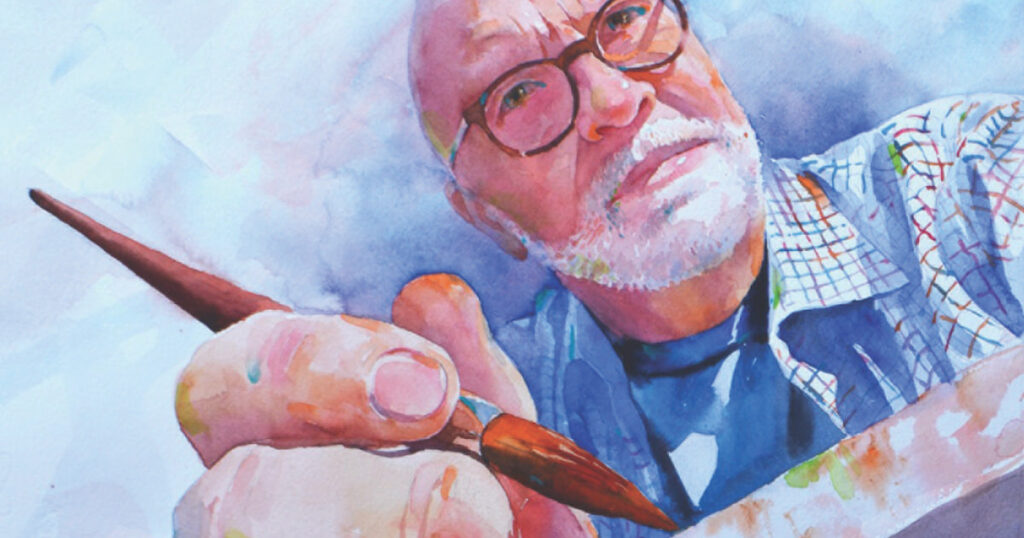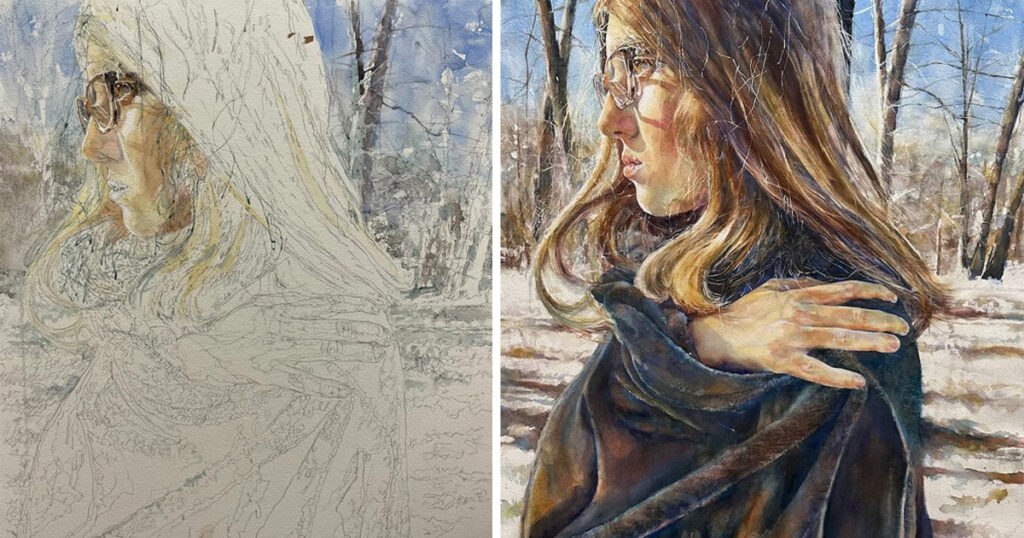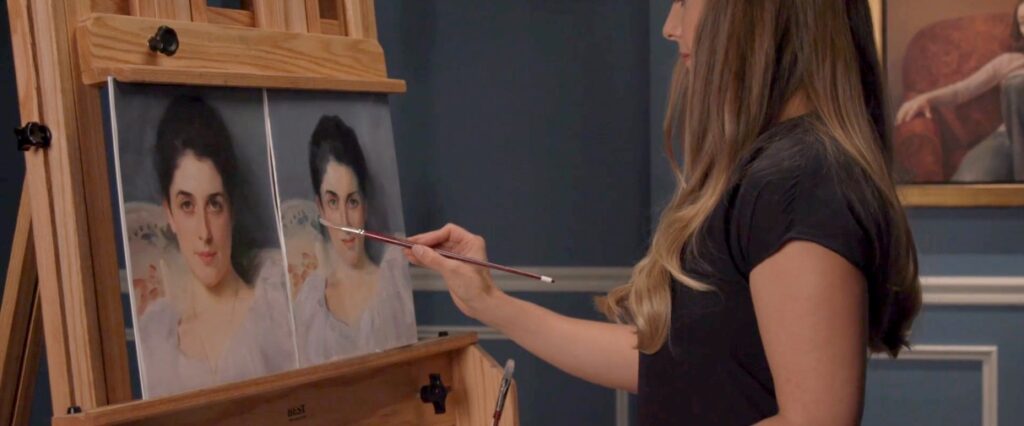Generate New Ideas and Test the Waters with an Art Journal

Keep an art journal to trace your creative path
by Cathy Johnson
Art journals open doors to our unique brands of creativity as places to plan, dream, respond to something that catches our eye and process the events in our lives. Inside we can sketch; test new colors, tools or materials; practice a variety of washes or techniques; doodle; plan larger works; try out concepts and compositions; and even complete paintings. We can explore our emotional responses to scenes and events in an art journal as well, and can feel safe to express them honestly. By paying attention to the beauty and magic of the everyday, we notice more and more. Life is suddenly richer, deeper, more meaningful, and the heightened creativity and confidence we’ve gained from the practice of cultivating such a record reflects that.
By paying attention to the beauty and magic of the everyday, we notice more and more. Life is suddenly richer, deeper, more meaningful, and the heightened creativity and confidence we’ve gained from the practice of cultivating such a record reflects that.
A Craving to Capture and Reflect
Keeping an art journal is a longstanding practice going back hundreds of years. In the 18th century and earlier, naturalists and archaeologists kept illustrated journals to document their travels and explorations. In Victorian times, women often kept scrapbooks to record family history or special events. Two of the most influential recent art journalists have been Hannah Hinchman, who wrote her first book on the subject in the late 1980s, and Danny Gregory, whose Everyday Matters (2003, Princeton Architectural Press) still inspires thousands of artists to pay attention to the commonplace, and record it in ink and watercolor.
Why a Watercolor Art Journal
For me, watercolor and journaling make a natural marriage. The fluidity of watercolor allows you to fully experience the moment as inspiration strikes, and then turn the page, leaving a record of the days and hours. You can add notes, whole pages of text, or the date alone, letting splashes of watercolor— bright or subdued—express your mood. As you revisit your journal pages for inspiration or sheer pleasure, the images alone will often be enough to trigger your memories. (A great memory that could be in the making for you is attending Artists Network’s SketchKon — the first ever event devoted to drawing, sketching, journaling and community!) Like most things in life, you get out of an art journal what you put into it. Since it can be kept entirely private, you don’t have to be afraid to express yourself honestly. Give yourself permission to be less than perfect. And if you find you’re comfortable sharing your journal pages, you may just liberate others to explore and forge their own creative paths in doing so.Be Prepared
I used to journal with only a technical pen for both words and pictures, but once I started adding watercolor, my whole approach changed, along with my needs. Cheap, flimsy pages that wouldn’t take a light wash of color wouldn’t cut it. Now, even when I plan a monochromatic scene or black-and-white page, very often that siren call of watercolor wins over and my pages blossom with color.

Be Ready to Revisit
Years ago, my favorite sketching tools were a dark-hued colored pencil and a watercolor wash of black, warm dark gray, even indigo or black raspberry. Somehow, once I fell in love with the varied lines of a fountain pen, I drifted away from these. But recently, the urge hit me to revisit these ‘old friends.’ I found an indigo pencil [an old Prismacolor] in my kit, and a glorious, shady bench by the river. The tree was old and gnarled and autumn’s hues were just coming in, providing a colorful backdrop for my sketch. Reach for a tool you haven’t used in awhile and share the results with us: @ArtistsNetwork on Instagram and tag it with #everywatercolor.
Take the Plunge
+Use a pencil or pen and ink to add notes about the sights, sounds, scents and even your mood. +Write quickly to capture whatever is foremost in your mind, or wait a moment to absorb the scene and let what you’re seeing or feeling sink in. +You can even include a bit of poetry. Just don’t stress about it. The important thing is to be honest. +Choose interesting lettering for your notes or page titles. +Add graphs, grids or lists—feel free to post your to-do list, or an e-mail message you may need later. +Stick in a photo, business card, stamp, ticket, menu or brochure that helps capture the moment and complements your watercolor sketches to make for a richer page.Resist Certain Temptations
Don’t let yourself be beguiled by journals with lined or pre-dated pages, or those with inspirational sayings or illustrations. These details can stifle your individual creativity. Of course, do be sure to date your entries as you make them; your journal can then serve as a reminder of where you’ve been and how you compare today. Unlike working on a full or half sheet, journal-sized watercolor paper—usually small enough to fit in a pocket, purse or backpack—is easier to work with, more intimate and perhaps less intimidating. Buckling isn’t usually a problem when you’re working at 5 x 7, 8 x 8 or 9 x 12 inches; 90-lb. and 140-lb. papers work best. Of course, the dimensions of your journal are up to you. Experiment to find the size you like best. Depending upon the circumstances, you may like a small one for your purse, pocket or glove box, and a larger one for when you know you’ll have more time or room to work. Making a wash, whether flat, graded or variegated, is easier on a journal-sized page than it is on the larger sizes. You can use smaller brushes and less paint than you need for large-scale work.
Kit Essentials
In general, the supplies you need for journaling can be relatively simple and lightweight: A small travel set of colors or an inexpensive folding palette A pencil or pen or two A couple of brushes A source of water A journal …these are really all you need! If you choose a waterbrush for your journal work, you’ll simplify your kit further, as the water supply is contained in the handle of the brush. I especially like these for travel or on-the-spot journaling. I’ve even painted on the tray table of an airplane seat. (Note: waterbrushes hold about a tablespoon of water at most, so you’ll still need a reasonably close water source if you plan to paint much and avoid mud.) Many journal keepers choose the simplest, least expensive supplies. Some even use kids’ or student-grade paints and are quite happy with them. I prefer artists’ grade paints, however, and would encourage you to use them as well. Watercolor can be challenging enough without fighting your paints or getting weak, unsaturated or chalky color.Explore with Gouache
There’s no reason to limit yourself to transparent watercolor in your journal. Experiment with gouache (sometimes called opaque watercolor or body color) on both white and toned paper—it creates an almost three-dimensional effect on a mid-toned paper. Gouache is water-soluble, so it’s clean and mixable, but it’s opaque, so you don’t have to plan ahead to reserve your lightest lights with mask, or paint around them. I removed the pans of watercolor from a small plastic paint box and replaced them with gouache for a lightweight set that travels everywhere I go. Sometimes I incorporate ink or a dark colored pencil with my gouache sketches, as I do with my regular watercolor journal, especially on toned or colored paper. You can prepare your own toned paper with gouache, acrylic or ink. Of course, the medium has been in use by designers and botanical artists for generations. Some brands, pigments or older paints tend to crumble a bit when allowed to dry on the palette, and may not re-wet as readily as watercolor. Popular brands of the medium among journal keepers are Schmincke and M. Graham gouache.
Art Supply Choices
Paints
Pan or tube paints? That’s a personal decision. I usually buy tubes and fill my own pans. I prefer the full pans (5⁄8 x 1 inch) to half (5⁄8 x ½ inch), so I can get a big brush in there for juicy washes. (You can find empty watercolor pans online; I usually order mine from Daniel Smith Art Supplies.) I let the colors set in the pans for a day or two before taking them out and about, so they won’t run. Note: Some paints are made with honey rather than gum arabic as a binder, and they may continue to run in humid conditions.Brushes
For brushes, you might prefer kolinsky red sable for studio work, but for journaling, try some of the man-made brushes. Grumbacher Golden Edge, Loew Cornell Stain or Ultra, Princeton and other synthetic-hair brushes have all come a long way from the man-made brushes I grew up with. They hold a lot of water, have good spring, and the rounds hold a nice point. Plus, they’re inexpensive enough that you won’t worry about them, especially if you journal en plein air.Journals
American Journey, Hand Book, Moleskine, Stonehenge, Fabriano, Canson, Arches and Strathmore are popular journal brands with many journal keepers. Or you may prefer a handmade journal filled with your own favorite paper. You’ll probably want to use hot-pressed paper, or at most cold-pressed, so you can write notes easily; pens and pencils seem to skip too much on rough papers. You may even want to bind in some sheets of smoother, lighter paper for writing notes. If making your own journal seems overwhelming, you might try using loose sheets and have them bound after the fact.Tools for Travel
A watercolor art journal is also a natural fit for travel sketching. Historically, those taking the Grand Tour would sketch their travels in watercolor. For travel sketching, most likely you’ll want to simplify and lighten your gear even further. I weigh my materials on a postal scale before ever leaving home, and usually take the lightest palette that will also be the most versatile. Plastic palettes are usually lighter than metal, and a small palette weighs less than a full-sized one. If you research where you’re going ahead of time, you can likely figure out if you’ll want more warm or cool colors in your travel palette. When I plan to paint in the desert, I may switch out some of my typical colors, leaving most of the wintry blues and tropical greens behind, which is easy to do if I’ve used removable pans.

In the interests of small, I tried out some quick thumbnail sketches of a favorite spot, and was ready to take on more! What a great little travel kit.
Carry On
Consider how you’ll carry your supplies into the field. There are any number of field bags for artists out there, but unless you’re taking a long trip or plan serious plein air painting, they’re often too much for journal work—too big, too heavy or too complex. They tempt us to carry much more than we’ll ever need. Many travel journalers reduce their kits to what they can carry in their pockets: usually the journal, a small travel set of watercolors, a pen, pencil and a couple of waterbrushes. I normally carry a small messenger bag that doubles as my purse. It holds a collection of pencils, pens and waterbrushes held together with a rubber band; a pencil tin of larger watercolor brushes and a small, stiff bristle brush; a bit of wax candle or white crayon for dry resists; an eraser; and a tiny dip pen. A pencil sharpener, small water container and a camping salt shaker with a lid (for texture) complete my “everywhere kit.” Add a driver’s license, credit card, aspirin and lip gloss, and I’m ready to go anywhere!
An Art Journal Outdoors
Don’t miss the chance to take your art journal out for a breath of fresh air in the great outdoors as Cathy recommends. You’ll be set to sketch whatever your eye spies after exploring the techniques and strategies of outdoor painting with Plein Air Painting: Techniques for Speed and Confidence Course. You will know how to lay out a composition, blocking in major shapes, managing the changing light and more by the time the video workshop is complete. Enjoy!





I can tell I wrote this article a while back–I haven’t used a Waterman Phileas pen in ages, or Lamy! Mostly, these days, Pilot Metropolitan, Noodler’s Creaper, or a TWSBI. And I hadn’t discovered Stillman & Birn’s lovely journals and sketchbooks at the time, either…delightful!
But I’m still at it, after all these years…
This is one of the best articles I have ever read. Cathy’s work and writings are very encouraging.
This is the type of information I expect from Artists Network.
I am so tired of the emails that are no more than postings to sell the books and DVD’s.
Great article. I love travel/daily journaling and carry a 4×4 Journal & kit (tiny Altoid tin with 6 colors, mister, water brush, 0 Ishabey travel mop, black pen, paper towel, test strips all in a see through 5×7 makeup bag) in my purse and the small Stillman & Birn Nova Grey journal and a gouache kit in my car. Just graduated myself from 5×8 to a 7×10 landscape journal for everyday and anxious to try an 8×10 Stillman & Birn portrait size next (Alpha). This is addictive. I should mention I also carry a fully equipped tripod and plein air set up at the ready in my car if I want to spend a few hours somewhere. I have no space for a studio, so this suits me well. Cathy Johnson, Liz Steel, Marc Taro-Homes, Brenda Swenson, Jane Blundell have helped me immeasurably as have other artist found here at Artist Network that I love and learn from…Thomas Schaller, Jean Haines, Charles Reid just to name a few, but whose work I especially like. Love my subscription to Watercolor Artist magazine. I would encourage anyone considering this to jump in, its never too late (or too early – I take my 5 yr old grandson along when I have him, and have given him his own sketch kit – he loves it!). Thanks again for great articles and offerings. I hope it encourages more to take the plunge.